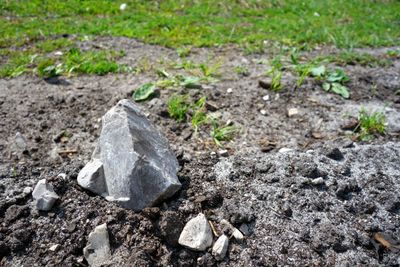Dealing with Rocky Soil
Oftentimes, when new homes are built, soil fill or topsoil are brought in to create a future lawn. However, this layer of fill or topsoil is usually only spread 4-12 inches (10-30.5 cm.) deep, using whatever inexpensive fill they can to get by. Normally, a depth of 4 inches (10 cm.), which is sufficient for lawn grasses to grow in, is what you get. What this means is that when you go to plant your landscape or garden, it is not long before you hit the rocky subsoil that lies beneath the illusion of a lush green yard. If you’re lucky or specifically requested it, the contractor puts in topsoil of at least 12 inches (30.5 cm.) deep. Besides being backbreaking work, rocky soil can make it harder for certain plants to take root and absorb essential nutrients. And with the earth’s crust and mantle literally made up of rocks, and the constant movement of plates along with intense heat from the core of the earth, these are continuously pushed up to the surface. This basically means that you could spend years trying to dig out all the troublesome rocks in the garden only to have more come up in their place.
How to Get Rid of Rocks in Soil
Plants and nature have learned to adapt to the rocky subsoil of earth by creating natural deposits of organic matter on top of the rocks below. When plants and animals die in nature, they decompose into nutrient-rich organic matter that future plants can root and thrive in. So while there really is no quick, easy remedy of how to get rid of rocks in the soil, we can adapt. One method of dealing with rocky soil is to create raised beds or berms for plants to grow in, above the rocky soil. These raised beds or berms should be at least 6 inches (15 cm.) deep, but the deeper the better for larger, deep rooting plants. Another method of dealing with rocky soil is to use plants that grow well in rocky conditions (yes, they do exist). These plants usually have shallow roots and low water and nutrient needs. Below are some plants that grow well in rocky soil:
Alyssum Anemone Aubrieta Baby’s Breath Baptisia Bearberry Bellflower Black Eyed Susan Bugleweed Candytuft Catchfly Catmint Columbine Coneflower Coreopsis Crabapple Dianthus Dogwood Gentian Geranium Hawthorn Hazelnut Hellebore Holly Juniper Lavender Little Bluestem Magnolia Milkweed Miscanthus Ninebark Prairie Dropseed Red Cedar Saxifraga Sea Thrift Sedum Sempervivum Smoke bush Sumac Thyme Viola Yucca
